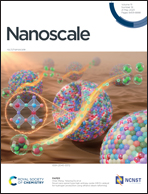Real-time monitoring of phase transitions in π-SnS nanoparticles†
Abstract
While the new cubic phase of tin monosulfide, π-SnS, shows potential for various applications, not much work was focused on the phase transitions, thermal stability, and thermal properties of π-SnS. In this work, we addressed these issues using temperature-resolved in situ X-ray diffraction combined with thermo-gravimetric differential scanning calorimetry and thermo-gravimetric infrared spectroscopy. The cubic π-SnS phase nanoparticles capped with polyvinylpyrrolidone were proven stable for 12 hours at 400 °C, pointing out the possible utilization of this new cubic phase at elevated temperatures. At the same time, heating above this temperature resulted in a phase transition to the high-temperature orthorhombic β-SnS phase. Subsequent cooling to room temperature led to an additional phase transition to the stable orthorhombic α-SnS phase. Interestingly, heating-induced phase transformation of π-SnS nanoparticles always resulted in β-SnS, even at temperatures below the α- to β-SnS equilibrium transition temperature. It was shown that surfactant decomposition and evaporation triggers the phase transition. Several thermal parameters were calculated, including the phase transition activation energy and the thermal expansion of the unit cell parameter of π-SnS.



 Please wait while we load your content...
Please wait while we load your content...